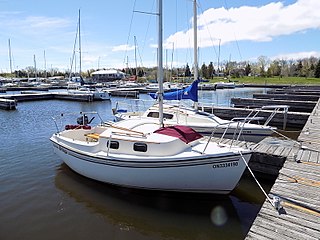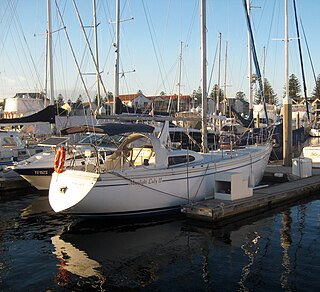Related Research Articles

The Rob Roy 23 is an American trailerable sailboat, that was designed by Edward S. Brewer and first built in 1980. The design is out of production.

The Sanibel 18 is an American trailerable sailboat, that was designed by Charles Ludwig, first built in 1982 and named for the Floridian town and island.
The Pearson Electra is an American trailerable sailboat that was designed by Carl Alberg as a Midget Ocean Racing Club (MORC) racer and first built in 1960.
The Island Packet 27 is an American sailboat that was designed by Robert K. Johnson as a cruiser and first built in 1984.
The Watkins 23 is an American trailerable sailboat that was designed by Johannes "Jopie" Helsen, modified by Watkins Yachts and first built in 1973.

The Columbia 34 Mark II is an American sailboat that was designed by William H. Tripp Jr. as a coastal cruising sailboat and first built in 1970.
The Columbia 34 is an American sailboat that was designed by Wirth Munroe and Richard Valdez as a cruiser and first built in 1966.
The Columbia 33 Caribbean is an American sailboat that was designed by Wirth Munroe as deep water cruiser and first built in 1963.
The Columbia 38 is an American sailboat that was designed by Charles Morgan as racer-cruiser and first built in 1965.
The Sabre 38 is an American sailboat that was designed by Roger Hewson and the Sabre Design Team as a racer-cruiser and first built in 1981.

The Cal 24 is an American trailerable sailboat that was designed by C. William Lapworth as a Midget Ocean Racing Club (MORC) racer and first built in 1958.
The Captiva 240 is an American trailerable sailboat that was first built in 1984. The boat is a development of the O.H. Rodgers-designed Rodgers 24 racer, modified for use as a racer-cruiser by Walter Scott by giving it a new keel and sailing rig.
The Coronado 23, also called the Sailcrafter 23, is an American trailerable sailboat that was designed by William Crealock as cruiser-racer and first built in 1969.
The Coronado 25 is an American trailerable sailboat that was designed by Ed Edgar and Frank W. Butler as a cruiser and first built in 1966.
The Ericson 25, also called the Ericson 25 Mark I is an American trailerable sailboat that was designed by Bruce King as a cruiser and first built in 1973.
The S2 7.0 is an American trailerable sailboat that was designed by Arthur Edmunds as a cruiser and first built in 1975. The designation indicates the approximate length overall in meters.
The Seafarer 29 is an American sailboat that was designed by McCurdy & Rhodes as an International Offshore Rule Half Ton class racer-cruiser and first built in 1972.
The Seidelmann 24, sometimes called the Seidelmann 24-1, is an American trailerable sailboat that was designed by Bob Seidelmann, Bruce Kirby and W. Ross, as a racer-cruiser and first built in 1981.
The Spirit 23, also called the North American 23, is an American trailerable sailboat that was designed by Robert Finch as a cruiser and first built in 1978.
The Triton 21, also called the Pearson 21, is an American trailerable sailboat that was designed by Clark Scarborough as a racer-cruiser and first built in 1985.
References
- 1 2 3 4 5 6 7 8 McArthur, Bruce (2019). "Columbia 40 sailboat". sailboatdata.com. Archived from the original on 25 November 2018. Retrieved 2 December 2019.
- ↑ McArthur, Bruce (2019). "Charles Morgan". sailboatdata.com. Archived from the original on 25 November 2018. Retrieved 2 December 2019.
- 1 2 3 Columbia Yachts (2019). "Columbia 40". columbiayachts.com. Archived from the original on 9 March 2019. Retrieved 2 December 2019.
- 1 2 Columbia Yacht Owners Association. "Columbia 40 Specifications". columbia-yachts.com. Archived from the original on 20 May 2019. Retrieved 2 December 2019.
- 1 2 3 Columbia Yacht Owners Association. "Columbia 40 Skeleton". columbia-yachts.com. Archived from the original on 28 April 2019. Retrieved 2 December 2019.
- ↑ McArthur, Bruce (2019). "Columbia Yachts". sailboatdata.com. Archived from the original on 11 November 2019. Retrieved 2 December 2019.
- ↑ McArthur, Bruce (2019). "Columbia 34 sailboat". sailboatdata.com. Archived from the original on 25 November 2018. Retrieved 2 December 2019.
- ↑ Columbia Yacht Owners Association. "Columbia 34 Specifications". columbia-yachts.com. Archived from the original on 25 December 2018. Retrieved 2 December 2019.